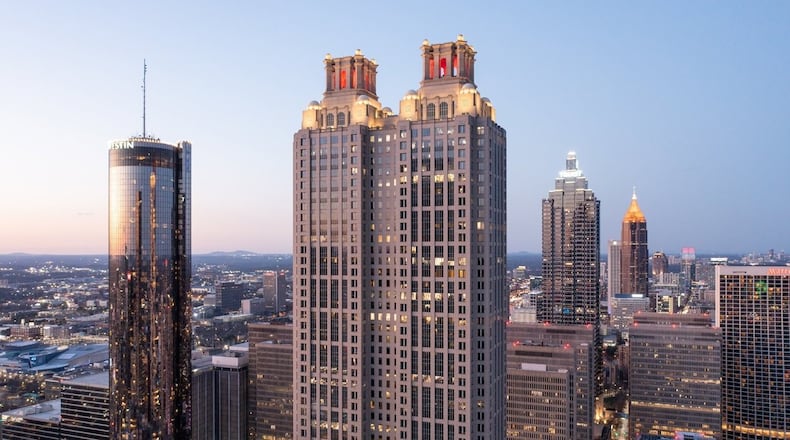The waters keep getting choppier for Atlanta’s office market on its post-pandemic voyage.
At the end of December, 32% of all office square footage in metro Atlanta was available to rent, according to data from real estate services firm CBRE. It’s the third financial quarter in a row where Atlanta set a record for its expanding sea of empty and unwanted office space, raising questions about how deep the market can sink before reaching the ocean floor.
“Everybody’s waiting for the bottom,” said Lawrence “LG” Gellerstedt IV, Atlanta market leader at commercial real estate firm Foundry Commercial.
The office market continues to be buffeted by waves caused by the COVID-19 pandemic, which popularized hybrid and remote work while capsizing workplace expansion plans. High interest rates, construction costs and a tight refinancing market have only exacerbated the pressure on office landlords overseeing half-empty buildings.
A lot of the available space comes from companies that are treading water and trying to find another business to sublease their unused offices. Nearly 9.3 million square feet of office was available for sublease at the end of the year — enough space to fill the city’s tallest building, Bank of America Plaza, more than seven times.
Despite the growing glut of office space on the market, asking rents have not decreased, especially at the city’s most expensive workplaces.
The average lease rate for top-quality buildings, referred to as Class A, at the end of December was $32.99 per square foot in metro Atlanta, according to CBRE. While that’s less than a 1% increase from the prior financial quarter, CBRE Associate Field Research Director Scott Amoson said its a sign that office tenants are still willing to pay for premium workspaces in desirable parts of the city.
Credit: Granite Properties
Credit: Granite Properties
“Some office buildings may benefit from lowering rents,” Amoson said. “Others, like the newest and fanciest buildings in Atlanta with well-capitalized landlords, can sit on their rates for a while and will continue to attract companies who are looking for high-quality spaces.”
Employers struggle to justify paying exorbitant rents for employees who primarily work from home, which has spurred new demands for workers to return to the office. Sandy Springs-based UPS announced last week it would require its employees to report to the office five days a week starting March 4, becoming one of the state’s largest companies to issue such a mandate.
John Robbins, senior managing director of Granite Properties, said other companies could follow suit, which has the potential to counteract some of the riptides facing Atlanta’s office market.
“When more of these larger companies make these announcements, it’ll give the smaller companies some ammunition to tell their people to return to the office,” he said.
Leasing slowdown
New office leasing in Atlanta sustained a drought during 2023.
The entire year saw negative absorption, a measure of how much the office rental market is expanding or contracting. Atlanta’s office market experienced nearly 2.9 million square feet of negative absorption during 2023, more than any other year since the 2020 COVID-19 shutdown, according to CBRE. The dour year reverses what had been a two-year recovery period and Amoson sees little light on the immediate horizon.
“I don’t see us veering off the path we’re on anytime soon,” he said. “The macroeconomic fundamentals that brought us to this place have not changed, and it’s unclear when they will.”
A struggling office market impacts the entire local economy, since commercial properties are key parts of city, county and school tax digests. Half-empty buildings, especially those built several decades ago, have struggled to attract tenants since the pandemic, which only further depresses their values.
Surging interest rates have made it difficult for landlords to sell their buildings at prices high enough to pay off their debts or to refinance loans coming due. It’s prompted many real estate experts to anticipate a wave of foreclosures to rip through the office market, with a few Atlanta landmarks like Peachtree Center’s office towers already returned to their lender.
However, several lenders have made short-term loan extensions or worked with landlords to avoid foreclosure, which Gellerstedt said is a sign that there’s a lot of fear over the long-term value of many of these distressed office buildings.
“There’s been a lot of groups out there with keys on the table and nobody wants to pick them up,” he said.
The Federal Reserve has signaled it will begin to cut interest rates this year, which commercial real estate experts said could take some pressure off the office market and spur new trading and leasing activity.
Flight to quality
While older and empty office buildings have struggled to stay above water, Atlanta’s newest and nicest workplaces have has wind in their sails.
Most of the leasing activity to take place during 2023 was at Class A buildings, a trend called “flight to quality.”
Banyan Street Capital, a Miami-based real estate firm, said it signed more than 40,000 square feet of lease transactions last year at 191 Peachtree Tower, the fourth-tallest building in Atlanta. The tower is now more than 85% leased.
Zac Gruber, president of Banyan Street Capital’s office division, said it’s been easier to find tenants willing to sign leases for smaller office spaces, since larger companies have been hesitant to commit to long-term workplaces while evaluating their office footprints and remote work policies.
“Smaller available spaces, both direct and sublease, tend to move much quicker,” Gruber said.
Credit: Granite Properties
Credit: Granite Properties
Robbins’ firm, Granite Properties, signed five new leases during the fall that combine for 198,000 square feet in metro Atlanta. The leases were at 100 City View in the Cumberland submarket, 3630 Peachtree in Buckhead and Midtown Union, a $1.1 billion mixed-use development that opened last year.
New construction is slowing down, which Robbins said will only make Class A buildings more desirable. According to CBRE, only about 2 million square feet of new offices were under construction at the end of 2023, a 27% decrease from the prior year.
“(Class A) will continue to do well because development is virtually halted,” Gellerstedt said. “And the people that do want space… want the nicest building to justify people coming in.”
Wanted: Office Tenants
Metro Atlanta had a record amount of available office space at the end of December, according to data from CBRE. Here’s some key figures:
Office availability rate: 32%
Space available for sublease: 9.3 million square feet
Net absorption: -1.1 million square feet
About the Author
Keep Reading
The Latest
Featured






